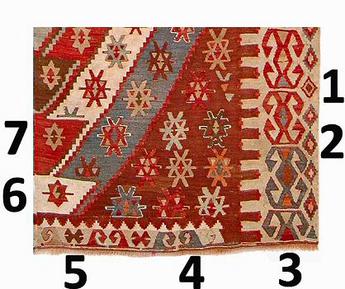
1) Eye (Göz) / Evil Eye (Nazarlık)
2) Eye, containing Cross (Haç)
3) Ram's Horn (Koçboynuzu)
4) Fertility (Bereket)
5) Wolf's Mouth (Kurt İzi)
6) Star (Yıldız), containing Love and Unison (Aşk ve Birleşim)
7) Star, containing Fetter (Bukaǧı)
Many motifs are used in traditional kilims, handmade flat-woven rugs, each with many variations. In Turkish Anatolia in particular, village women wove themes significant for their lives into their rugs, whether before marriage or during married life. Some motifs represent desires, such as for happiness and children; others, for protection against threats such as wolves (to the flocks) and scorpions, or against the evil eye. These motifs were often combined when woven into patterns on kilims. With the fading of tribal and village cultures in the 20th century, the meanings of kilim patterns have also faded.
In these tribal societies, women wove kilims at different stages of their lives, choosing themes appropriate to their own circumstances. Some of the motifs used are widespread across Anatolia and sometimes across other regions of West Asia, but patterns vary between tribes and villages, and rugs often expressed personal and social meaning.
© MMXXIII Rich X Search. We shall prevail. All rights reserved. Rich X Search
